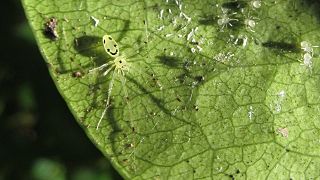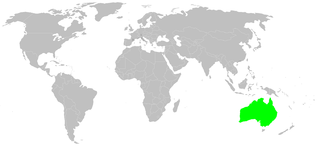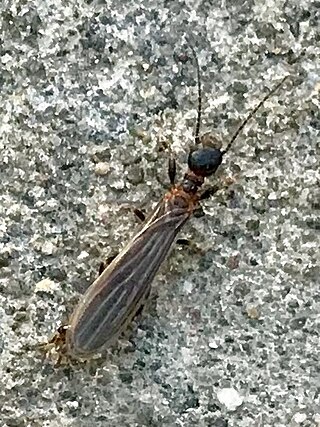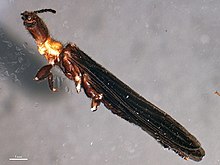
Wasps in the family Pompilidae are commonly called spider wasps, spider-hunting wasps, or pompilid wasps. The family is cosmopolitan, with some 5,000 species in six subfamilies. Nearly all species are solitary, and most capture and paralyze prey, though members of the subfamily Ceropalinae are kleptoparasites of other pompilids, or ectoparasitoids of living spiders.

The order Embioptera, commonly known as webspinners or footspinners, are a small group of mostly tropical and subtropical insects, classified under the subclass Pterygota. The order has also been called Embiodea or Embiidina. More than 400 species in 11 families have been described, the oldest known fossils of the group being from the mid-Jurassic. Species are very similar in appearance, having long, flexible bodies, short legs, and only males having wings.
A trophic egg is an egg whose function is not reproduction but nutrition; in essence, the trophic egg serves as food for offspring hatched from viable eggs. In most species that produce them, a trophic egg is usually an unfertilised egg. The production of trophic eggs has been observed in a highly diverse range of species, including fish, amphibians, spiders and insects. The function is not limited to any particular level of parental care, but occurs in some sub-social species of insects, the spider A. ferox, and a few other species like the frogs Leptodactylus fallax and Oophaga, and the catfish Bagrus meridionalis.

Treehoppers and thorn bugs are members of the family Membracidae, a group of insects related to the cicadas and the leafhoppers. About 3,200 species of treehoppers in over 400 genera are known. They are found on all continents except Antarctica; only five species are known from Europe. Individual treehoppers usually live for only a few months.

Ant mimicry or myrmecomorphy is mimicry of ants by other organisms. Ants are abundant all over the world, and potential predators that rely on vision to identify their prey, such as birds and wasps, normally avoid them, because they are either unpalatable or aggressive. Spiders are the most common ant mimics. Additionally, some arthropods mimic ants to escape predation, while others mimic ants anatomically and behaviourally to hunt ants in aggressive mimicry. Ant mimicry has existed almost as long as ants themselves; the earliest ant mimics in the fossil record appear in the mid Cretaceous alongside the earliest ants. Indeed one of the earliest, Burmomyrma, was initially classified as an ant.

Portia labiata is a jumping spider found in Sri Lanka, India, southern China, Burma (Myanmar), Malaysia, Singapore, Java, Sumatra and the Philippines. In this medium-sized jumping spider, the front part is orange-brown and the back part is brownish. The conspicuous main eyes provide vision more acute than a cat's during the day and 10 times more acute than a dragonfly's, and this is essential in P. labiata′s navigation, hunting and mating.

Theridion grallator, also known as the Hawaiian happy-face spider, is a spider in the family Theridiidae that resides on the Hawaiian Islands. T. grallator gets its vernacular name of "Hawaiian happy-face spider" from the unique patterns superimposed on its abdomen, specifically those that resemble a human smiling face. T. grallator is particularly notable because of its wide range of polymorphisms that may be studied to allow a better understanding of evolutionary mechanisms. In addition to the variety of color polymorphisms present, T. grallator demonstrates the interesting quality of diet-induced color change, in which its appearance temporarily changes as it metabolizes various food items.

Phryganoporus candidus, also known as the foliage web spider, is a small, subsocial jumping spider endemic to Australia. On average, they are 6–10 mm long and are a mottled brown colour, covered in silvery grey hair. They typically reside in arid and semi-arid locations, building their nests in various trees, bushes, and other plant-life. They have a mutualistic relationship with Acacia ligulata, and therefore prefer to build their nests in these trees.

Stegodyphus lineatus is the only European species of the spider genus Stegodyphus. Male S. lineatus can grow up to 12 mm long while females can grow up to 15 mm. The colour can range from whitish to almost black. In most individuals the opisthosoma is whitish with two broad black longitudinal stripes. Males and females look similar, but the male is generally richer in contrast and has a bulbous forehead. The species name refers to the black lines on the back of these spiders. S. lineatus is found in the southern Mediterranean region of Europe and as far east as Tajikistan.

Amaurobius ferox, sometimes known as the black lace-weaver, is a common nocturnal spider belonging to the family Amaurobiidae and genus Amaurobius. Its genus includes the permanently social species A. socialis, and three subsocial species, A. fenestralis, A. similis and A. ferox, all three of which have highly developed subsocial organizations.

Jalmenus evagoras, the imperial hairstreak, imperial blue, or common imperial blue, is a small, metallic blue butterfly of the family Lycaenidae. It is commonly found in eastern coastal regions of Australia. This species is notable for its unique mutualism with ants of the genus Iridomyrmex. The ants provide protection for juveniles and cues for adult mating behavior. They are compensated with food secreted from J. evagoras larvae. The ants greatly enhance the survival and reproductive success of the butterflies. J. evagoras lives and feeds on Acacia plants, so butterfly populations are localized to areas with preferred species of both host plants and ants.

A wasp is any insect of the narrow-waisted suborder Apocrita of the order Hymenoptera which is neither a bee nor an ant; this excludes the broad-waisted sawflies (Symphyta), which look somewhat like wasps, but are in a separate suborder. The wasps do not constitute a clade, a complete natural group with a single ancestor, as bees and ants are deeply nested within the wasps, having evolved from wasp ancestors. Wasps that are members of the clade Aculeata can sting their prey.
Tarachodes afzelii, commonly known as the Tanzanian ground mantis, is a species of praying mantis in the family Eremiaphilidae. It is native to woodland in Western and Central Africa.

Spiders are air-breathing arthropods that have eight legs, chelicerae with fangs generally able to inject venom, and spinnerets that extrude silk. They are the largest order of arachnids and rank seventh in total species diversity among all orders of organisms. Spiders are found worldwide on every continent except for Antarctica, and have become established in nearly every land habitat. As of August 2022, 50,356 spider species in 132 families have been recorded by taxonomists. However, there has been debate among scientists about how families should be classified, with over 20 different classifications proposed since 1900.
Archipsocus nomas is a web-spinning barklouse, a psocid in the insect family Archipsocidae. It is found in the southeast of the United States, living gregariously on trees, feeding on lichen and fungi and spinning a web that adheres to the trunk and large branches in sheets. The webs are thought to protect the barklice from predators and neither the insects nor the webs cause damage to the trees.

Structures built by non-human animals, often called animal architecture, are common in many species. Examples of animal structures include termite mounds, ant hills, wasp and beehives, burrow complexes, beaver dams, elaborate nests of birds, and webs of spiders.
Stegodyphus sarasinorum, also known as the Indian cooperative spider, is a species of velvet spider of the family Eresidae. It is native to India, Sri Lanka, Nepal, and Myanmar. This spider is a social spider that exhibits communal predation and feeding, where individuals live in large cooperatively built colonies with a nest or retreat constructed of silk woven using leaves, twigs, and food carcasses, and a sheet web for prey capture.

Oligotoma saundersii, commonly known as Saunders' embiid, is a species of webspinner, an insect in the order Embiidina, also known as Embioptera.

Stegodyphus dumicola, commonly known as the African social spider, is a species of spider of the family Eresidae or the velvet spider family. It is native to Central and southern Africa. This spider is one of three Stegodyphus spiders that lives a social lifestyle. This spider has been studied living in large natal colonies in large, unkempt webs. Each colony is composed mainly of females, where a minority act as reproducers, and a majority remain childless and take care of the young. Males live a shorter lifespan and will largely remain in the natal nest throughout its life. Females are known for extreme allomaternal care, since all females, even unmated virgin females will take care of the young until they are eventually consumed by the brood.
Aposthonia ceylonica is a species of webspinner of the family Oligotomidae native to tropical Asia, Madagascar and Mauritius. In February 2019, a colony of this insect was identified in a greenhouse at the RHS Garden, Wisley, Surrey, England, on the roots of an orchid. It was thought that the insects had been accidentally introduced on plants imported from Thailand.















